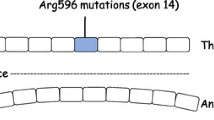Abstract
We investigated the behavior of prothrombin fragment F1+2 and thrombin-antithrombin complexes in 70 patients treated with chronic anticoagulant therapy. Moreover, in a longitudinal study 37 patients were evaluated twice and 16 patients three times. Twenty-eight age-and sex-matched healthy subjects were also studied as a control group. Prothrombin fragment F1+2 and thrombinantithrombin complexes were significantly higher in controls than in patients on anticoagulants. There were no differences in prothrombin fragment F1+2 or thrombinantithrombin values among patients with different International Normalized Ratios, nor in the same patients studied two or three times. Our results confirm that oral anticoagulant treatment can effectively reduce thrombin activity. However, strong anticoagulation does not induce a further significant decrease in fragment F1+2 values. Therefore, we feel measurement of fragment F1+2 might be less useful than thought in optimizing oral anticoagulant therapy.
Similar content being viewed by others
References
British Society for Haematology. Guidelines on oral anticoagulation. J Clin Pathol 1990; 43: 177.
Marongiu F, Sorano GG, Mameli G, Mamusa AM, Cambuli AB, Conti M, Sanna MP, Farci P, Balestrieri A. Thrombin activity and oral anticoagulant therapy: a preliminary study. Haemostasis 1989; 19: 142.
Marongiu F, Sorano GG, Mameli G, Mamusa AM, Cambuli AB, Conti M, Cadoni MC, Balestrieri A. Thrombin activity and oral anticoagulant therapy: a further evaluation. Haemostasis 1990; 20:63.
Mannucci PM, Bottasso B, Tripodi A. Prothrombin fragment F1+2 and intensity of treatment with oral anticoagulants. Thromb Haemost 1991; 66:741.
Takahashi H, Wada K, Satoh N, Takakuwa E, Furuta R, Yoshino N, Shibata A. Evaluation of oral anticoagulant therapy by measuring plasma prothrombin fragment 1+2. Blood Coagul Fibrinolysis 1993; 4:435.
Solymoss S, Bovill EG. Markers of in vivo activation of coagulation. Interrelationships change with intensity of oral anticoagulation. Am J Clin Pathol 1996; 105:293.
Van den Besselaar AMHP. Recommended method for reporting therapeutic control of oral anticoagulation therapy. Thromb Haemost 1990; 63:316.
Pelzer H, Schwarz A, Stuber W. Determination of human prothrombin activation fragment F1+2 in plasma with an antibody against a synthetic peptide. Thromb Haemost 1991; 65: 153.
Pelzer H, Schwarz A, Heimburger N. Determination of human thrombin-antithrombin III complex in plasma with an enzymelinked immunosorbent assay. Thromb Haemost 1988; 59: 101.
Conway EM, Bauer KA, Barzegar S, Rosemberg RD. Suppression of haemostatic activation by oral anticoagulants in the blood of patients with thrombotic diathesis. J Clin Invest 1987; 80: 1535.
Author information
Authors and Affiliations
Rights and permissions
About this article
Cite this article
Barcellona, D., Biondi, G., Mameli, G. et al. Are prothrombin fragment 1+2 and thrombin-antithrombin complexes useful in the management of oral anticoagulant therapy?. Int J Clin Lab Res 27, 76–78 (1997). https://doi.org/10.1007/BF02827248
Received:
Accepted:
Issue Date:
DOI: https://doi.org/10.1007/BF02827248




